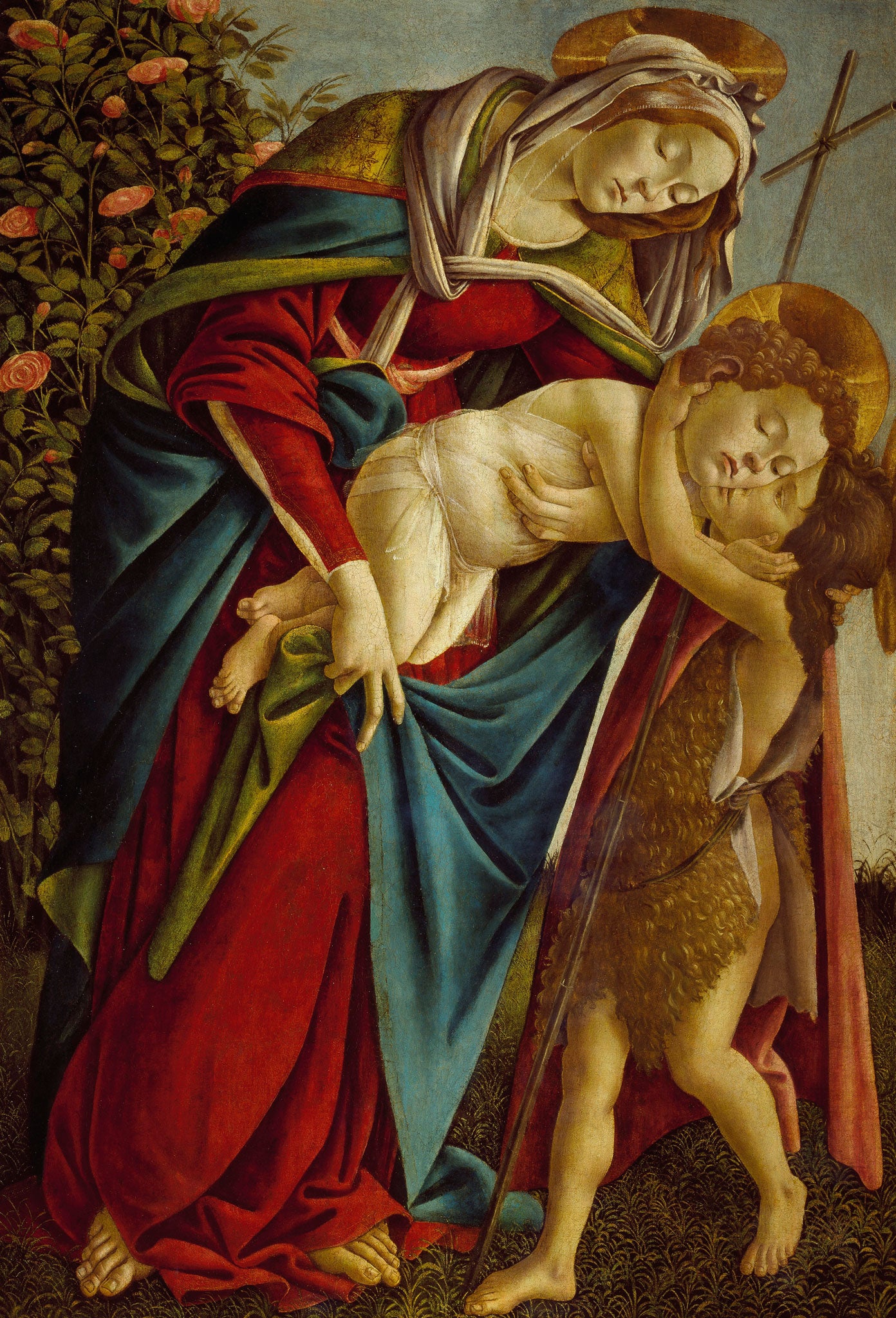Great Works: Madonna and Child with the Young St John (c1500) by Sandro Botticelli
Galleria Palatina, Florence

How uncharacteristic of the younger Botticelli is this late work! Think back, for example, to his Venus of 1482. That luscious painting shows nudity in all its full, hedonistic flow, with Venus herself, loosely and teasingly veiled, tenderly bunching a long wreathing of her auburn hair in her left hand as she simultaneously touches at her pudenda. She seems like a piece of antique statuary miraculously come alive in order to seduce us by the full force of her idling sensuality.
About two decades on, Botticelli reinvents himself. The painter of this work, from his final decade, seems to be clothed in sackcloth and ashes. There is a degree of archaism in this new, late style – the forms are flattened; Mary, towering, looks hierarchical – and a pious solemnity about the whole endeavour as if Botticelli is preparing the works that he will be showing to his Maker on the Last Day.
What exactly had happened in those intervening years? Two factors helped to bring about this dramatic change of brush and heart. One was the death of Lorenzo the Magnificent in 1492. At a stroke, Botticelli lost a great secular patron. You could even generalise, although somewhat loosely, that the death of Lorenzo meant the death of the humanist ideals of the Renaissance. Within two years of that event, his son Piero had been driven into exile, Pico della Mirandola had died, and the fear-inducing influence of a charismatic preacher was beginning to be felt. That man was Savonarola. Secular art was under threat, and the doctrines of this preacher were hotly debated in Botticelli's studio.
The movement of the painting is dramatic, that of a great cascading wave. As Mary leans down to the left (our right), so she allows her infant son to lean over and down too – his body looks a little like that of a swimmer, almost diving out of her arms and into the embrace of the child-like form of John the Baptist, his forerunner. See how closely the face of the virgin and her child seem to resemble each other, how alike, for example, are their downturned mouths. The space feels enormously constrained by the bulking of these bodies. Even the child looks huge for his age. They all push up, heavingly, against the painting's boundary walls. The Madonna herself would be enormous were she to ratchet herself upright. As she stoops and leans, so the gilded disc of her halo almost shaves off the top edge of the canvas.
The looks on the faces of the Virgin and her child have a strangely ritualistic, almost otherworldly, neutrality to them, as if they are living through a rapturous dream of their own lives – which means, of course, their destinies as the central figures in the world's greatest historical drama. They are going through the motions of that which is already known to them, and to all their contemporary onlookers too: the Passion. That is surely the reason why the infant embraces his prophetic forerunner with such vehemence. The audience is being reminded that John the Baptist too plays a significant role in the scheme of things, and it is entirely appropriate that these two infants should bond, physically, in this way.
And yet for all the evidence of this new piety, some of the old Botticelli is dynamically alive here too: look at the wonder of that vegetation, those roses, just to the left of the Virgin's back. Is this not evidence of natural abundance being enjoyed for its own sake?
About the artist: Sandro Botticelli (c 1445-1510)
Sandro Botticelli was born in Florence, and lived and worked at its moment of greatest flowering, intellectually and artistically speaking. This coincided almost exactly with the reign of one of his greatest patrons, Lorenzo the Magnificent. Part-trained and part-influenced by Fra Filippo Lippi, Verrocchio and the brothers Pollaiuolo, he re-imagined classical mythology through such great works as The Birth of Venus and Primavera. His reputation was eclipsed in old age by Leonardo and Michelangelo.
Subscribe to Independent Premium to bookmark this article
Want to bookmark your favourite articles and stories to read or reference later? Start your Independent Premium subscription today.

Join our commenting forum
Join thought-provoking conversations, follow other Independent readers and see their replies